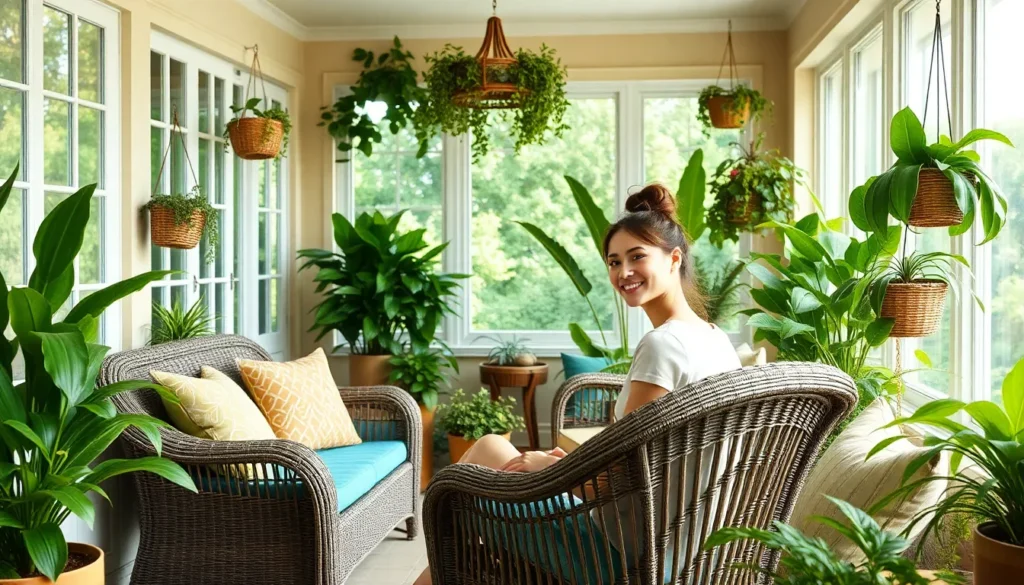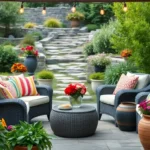We’ve all dreamed of that perfect sunroom—a bright sanctuary where indoor comfort meets outdoor beauty. These versatile spaces offer endless possibilities for creating your ideal retreat whether you’re sipping morning coffee surrounded by lush plants or hosting intimate gatherings bathed in natural light.
Transform your sunroom into a stunning extension of your home with the right decorating approach. From choosing weather-resistant furniture that withstands temperature changes to selecting plants that thrive in abundant sunlight these spaces require thoughtful design decisions that balance style with functionality.
We’ll explore creative decorating ideas that maximize your sunroom’s potential while reflecting your personal taste. Whether you’re working with a cozy three-season room or a fully climate-controlled four-season space these design strategies will help you create an inviting atmosphere that becomes your favorite spot in the house.
Choose Light and Airy Color Schemes
Light color palettes maximize the natural brightness that defines exceptional sunroom spaces. We recommend selecting hues that complement abundant sunlight while creating a seamless transition between indoor comfort and outdoor beauty.
Opt for Neutral Tones and Pastels
Neutral colors create the perfect foundation for sunroom decorating that feels both timeless and sophisticated. Soft beiges, warm grays, and gentle taupes work beautifully with natural light streaming through windows throughout the day. Pastel shades like sage green, dusty blue, and blush pink add subtle character without overwhelming the space’s inherent brightness.
These understated tones serve as excellent backdrops for weather-resistant furniture and seasonal accessories. Light sage walls paired with cream furnishings create a calming retreat that feels connected to garden views. Dusty lavender accents through throw pillows or lightweight curtains introduce gentle color while maintaining the airy atmosphere we want to achieve.
Incorporate White and Cream Bases
White and cream serve as the ultimate light-improving colors for sunroom environments where natural illumination takes center stage. Pure white walls reflect maximum sunlight back into the space, making even smaller sunrooms feel spacious and inviting. Cream tones offer warmth while maintaining that bright, open feeling that makes sunrooms so appealing.
We suggest using white or cream for major elements like wall paint, window treatments, and primary seating pieces. Off-white wicker furniture creates classic sunroom style while cream-colored area rugs define seating zones without blocking light flow. These neutral bases allow the outdoor views to become the room’s natural focal point while providing flexibility for seasonal decorating changes.
Add Pops of Color Through Accessories
Colorful accessories provide the perfect opportunity to introduce personality without committing to permanent design choices in your sunroom space. Bright throw pillows, vibrant artwork, and colorful planters create visual interest while maintaining the overall light and airy feeling. Coral cushions on white furniture bring energy, while turquoise vases add coastal charm that complements outdoor views.
Seasonal accessories let us refresh the sunroom’s look throughout the year without major renovations. Summer might call for yellow and orange accents that echo garden blooms, while winter could feature deep burgundy or forest green touches. Fresh flowers in colorful containers provide natural pops of color that change with the seasons and connect indoor spaces to the outdoor industry beyond the windows.
Select Weather-Resistant Furniture

Building on our foundation of light and airy colors, we need furniture that can handle the unique challenges of sunroom environments. The key is choosing pieces that maintain their beauty even though constant sunlight exposure and potential moisture fluctuations.
Invest in Wicker and Rattan Pieces
Wicker and rattan furniture delivers the perfect combination of natural aesthetic appeal and practical durability for sunrooms. These materials resist moisture naturally, making them ideal for spaces that experience humidity changes throughout the day. We love how lightweight these pieces are, allowing us to rearrange our sunroom layout seasonally or for different activities.
Natural wicker provides excellent ventilation, which helps prevent mold and mildew in humid conditions. Rattan pieces offer similar benefits while adding an organic texture that complements the outdoor connection we’re trying to achieve. Both materials work beautifully for indoor and outdoor transitions, giving us flexibility if we want to move furniture between our sunroom and patio areas.
Consider All-Weather Upholstery Fabrics
All-weather upholstery fabrics are game changers for sunroom comfort and longevity. These specially designed materials resist fading from UV exposure while maintaining their softness and visual appeal over time. We recommend looking for fabrics specifically labeled as weather resistant rather than standard indoor materials.
Performance fabrics like Sunbrella and similar brands offer exceptional durability without sacrificing style options. They’re engineered to handle temperature fluctuations and moisture without deteriorating, which means less frequent replacement costs. Many of these fabrics also feature stain resistance, making cleanup easier when we’re enjoying morning coffee or entertaining guests.
Choose Fade-Resistant Materials
Fade-resistant materials preserve our sunroom’s fresh appearance even though constant sun exposure throughout the seasons. Metal furniture pieces excel in this category, offering modern styling that’s easy to clean and maintain over years of use. Powder-coated aluminum and steel resist both fading and rust, making them excellent long-term investments.
We should also consider fade-resistant wood treatments and synthetic materials that mimic natural textures without the maintenance requirements. Bamboo furniture provides another excellent option, as it naturally resists sun damage while offering the warm, organic look we want in our sunroom spaces. These materials help ensure our carefully chosen color schemes remain vibrant and cohesive year after year.
Maximize Natural Light with Strategic Window Treatments
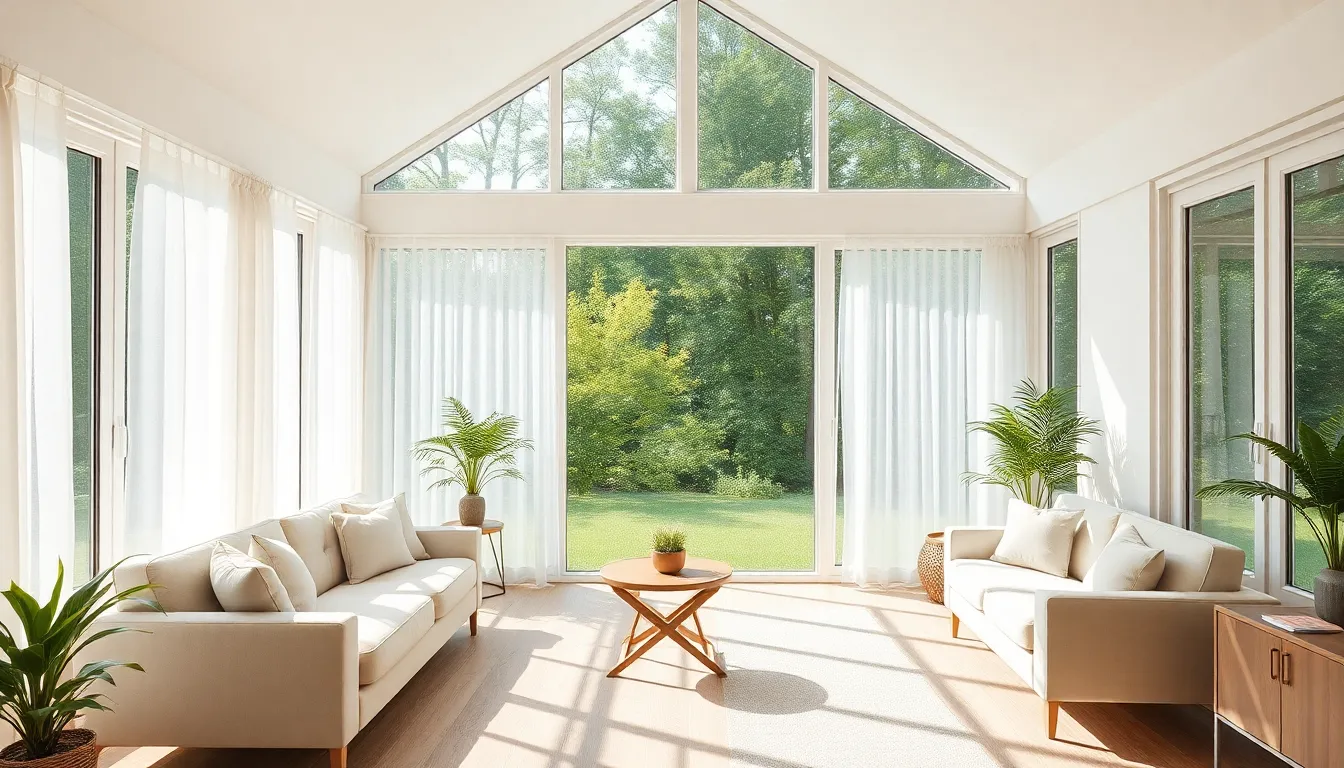
Now that we’ve established our foundation with light colors and durable furnishings, we need to address one of the most crucial elements of sunroom design: window treatments that enhance rather than block our precious natural light.
Install Sheer Curtains or Light Filtering Blinds
Sheer curtains transform harsh sunlight into a gentle, warm glow that fills our sunroom with inviting ambiance. These lightweight fabrics allow sunlight to diffuse naturally while providing a soft layer of privacy during the day. Light filtering blinds offer similar benefits with added flexibility, letting us adjust the amount of light entering our space throughout different times of day.
We can choose from various textures like linen sheers or bamboo light filtering blinds to complement our existing decor. These treatments maintain our connection to the outdoors while creating a comfortable environment that doesn’t feel overly exposed. The gentle diffusion effect helps reduce glare on furniture and prevents harsh shadows that can make our sunroom feel less welcoming.
Use Adjustable Shutters for Light Control
Adjustable shutters provide us with complete control over light levels as the sun moves across the sky throughout the day. These versatile window treatments allow us to fine tune the amount of sunlight entering our sunroom, creating different moods and atmospheres depending on our activities. Morning coffee sessions might call for fully opened shutters, while afternoon reading requires partially closed slats to reduce glare.
We can select from plantation style shutters for a classic look or modern panel shutters for contemporary sunrooms. The ability to adjust individual slats means we can direct light exactly where we want it while maintaining privacy from exact angles. This flexibility makes shutters particularly valuable for sunrooms that receive intense afternoon sun or those overlooking busy areas.
Consider Motorized Shades for Convenience
Motorized shades bring modern convenience to our sunroom lighting strategy with the simple push of a button. These automated window treatments allow us to adjust light levels instantly without leaving our comfortable seating area, making them perfect for large sunrooms with multiple windows or hard to reach installations. We can program them to adjust automatically based on time of day or sun intensity.
Smart motorized shades can integrate with our home automation systems, letting us create lighting scenes that perfectly match our daily routines. Some models include sensors that automatically adjust based on sunlight levels, ensuring optimal lighting without any effort on our part. This technology particularly benefits sunrooms with skylights or floor to ceiling windows where manual adjustment would be impractical.
Incorporate Abundant Greenery and Plants

Plants transform sunrooms into vibrant living spaces that celebrate the connection between indoor comfort and natural beauty. We’ll explore strategic approaches to maximize your sunroom’s plant potential while creating stunning visual displays.
Create a Living Wall with Vertical Planters
Vertical planters maximize our sunroom’s plant capacity by utilizing wall space efficiently. This approach showcases multiple plant varieties in a compact footprint while creating a striking focal point that draws the eye upward.
Living walls thrive in sunrooms because they receive consistent natural light from multiple angles. We can install modular planting systems that allow for easy maintenance and plant rotation as seasons change.
Strategic placement of vertical planters near windows ensures optimal light distribution across all plant levels. Different plant heights and textures create visual depth while maximizing the therapeutic benefits of abundant greenery.
Mix Indoor and Outdoor Plant Varieties
Indoor plants like African Violets and Snake Plants provide consistent greenery throughout the year in our sunrooms. These reliable performers adapt well to the controlled environment while requiring minimal maintenance.
Outdoor varieties such as Hibiscus and Orchids add dramatic blooms and seasonal interest to our plant collections. These plants benefit from the sunroom’s protected environment while bringing bold colors and exotic textures indoors.
Combining different plant categories creates ever-changing displays that change with seasons and growing cycles. We can rotate outdoor plants based on their blooming periods while maintaining a stable foundation of indoor varieties.
Use Hanging Baskets and Floor Planters
Hanging baskets add vertical interest with trailing plants like Ivy and Flamingo Flowers that cascade beautifully from above. These elevated displays draw attention to our sunroom’s height while creating layers of greenery at different levels.
Floor planters accommodate larger specimens such as Indoor Trees and Birds of Paradise that make bold architectural statements. These substantial plants anchor our design while providing privacy screening and dramatic focal points.
Combining hanging and floor arrangements creates a complete plant network that utilizes every available space. We can adjust basket heights and planter positions to optimize light exposure while maintaining easy access for care and maintenance.
Add Comfortable Seating Arrangements
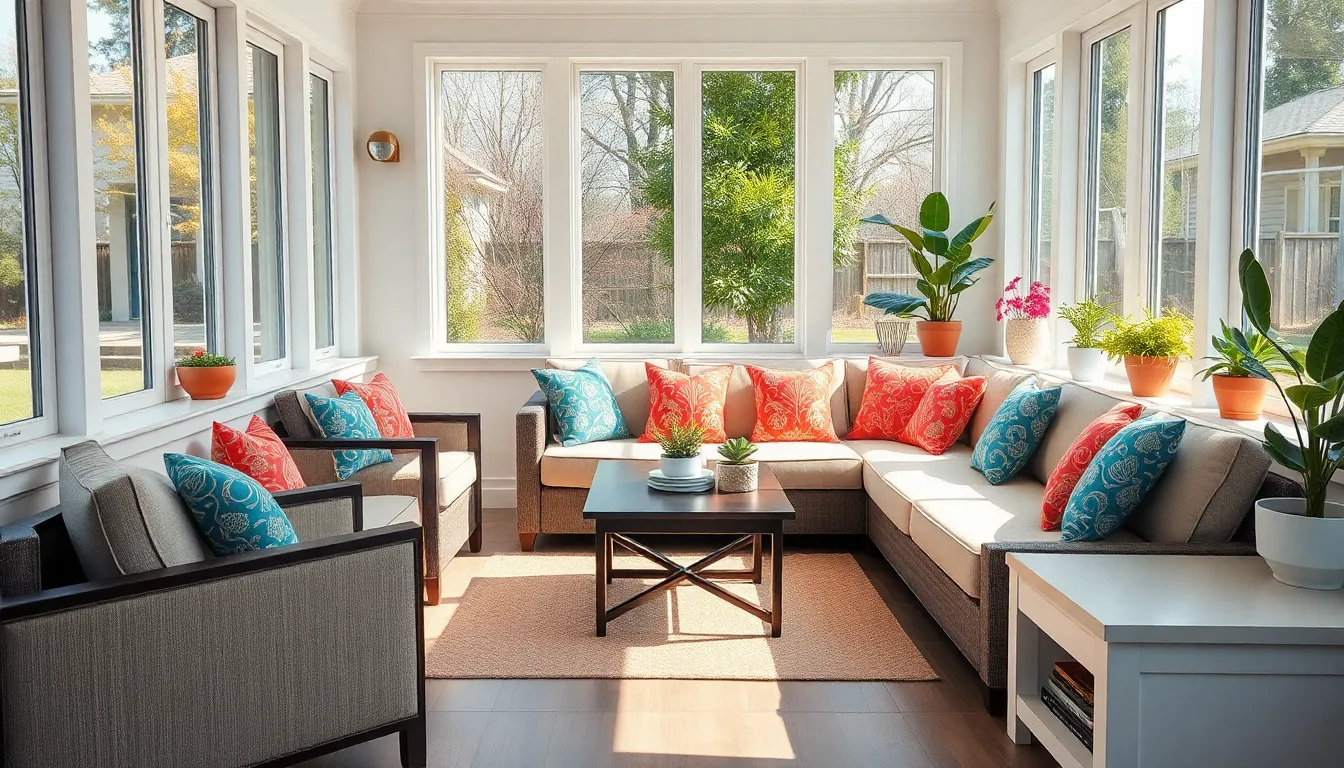
With your sunroom’s lighting and plant arrangements in place, let’s focus on creating seating that transforms this space into the ultimate comfort zone.
Create Multiple Conversation Areas
Dividing your sunroom into distinct zones maximizes functionality while creating intimate spaces for different activities. We recommend positioning a plush sectional near the garden view for morning coffee conversations and arranging armchairs around a side table for afternoon reading sessions. Consider placing a loveseat facing the backyard while keeping a single accent chair angled toward the indoor entrance to accommodate both outdoor admirers and indoor conversationalists.
Each conversation area should maintain its own unique charm through thoughtful furniture arrangements that encourage natural flow between spaces. Position furniture pieces at angles rather than pushing them against walls to create more ever-changing interaction zones. Floor rugs help define each area while maintaining visual connection throughout the sunroom, ensuring the space feels cohesive rather than chopped up.
Include Built-in Bench Seating with Storage
Built-in benches serve dual purposes by providing extra seating while keeping seasonal decorations and outdoor accessories organized. We suggest installing bench seating along windows to take advantage of natural light and views while creating hidden storage compartments underneath for throw blankets and gardening supplies. Custom built-ins can incorporate charging stations for devices and cup holders for added convenience during long relaxation sessions.
Storage benches work particularly well in smaller sunrooms where every square foot counts. Consider adding cushioned tops that match your existing furniture while ensuring the storage compartments are easily accessible. Built-in options can include pull-out drawers or lift-up lids depending on your exact storage needs and the items you plan to keep handy.
Add Outdoor Cushions and Throw Pillows
Vibrant outdoor cushions instantly transform basic seating into colorful focal points that can be swapped seasonally. We recommend choosing weather-resistant fabrics in bold patterns that complement your plant selections while adding texture and visual interest to neutral furniture pieces. Outdoor cushions perform better than indoor versions in sunrooms due to their fade-resistant properties and moisture-wicking capabilities.
Layering throw pillows in different sizes creates depth and comfort while allowing you to experiment with seasonal color schemes. Mix solid colors with patterned designs to avoid overwhelming the space, and choose pillows that coordinate with your window treatments for a cohesive look. Consider keeping extra pillow covers in storage so you can easily refresh your sunroom’s appearance throughout the year without purchasing entirely new accessories.
Install Proper Flooring for Sunroom Conditions
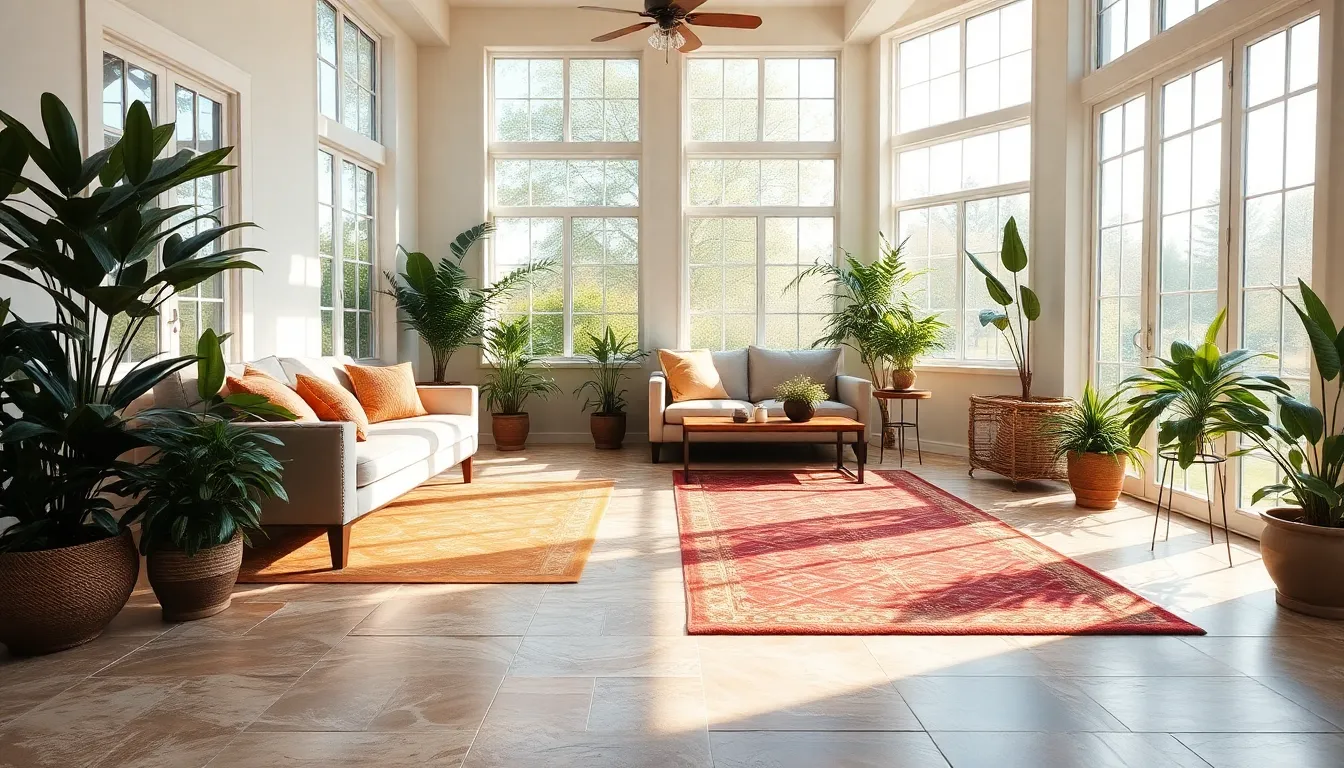
Selecting the right flooring sets the foundation for your sunroom’s long-term beauty and functionality. We’ll explore durable options that withstand moisture, temperature fluctuations, and constant sunlight exposure.
Choose Tile or Stone for Durability
Tile flooring delivers exceptional performance in sunroom environments where moisture and sunlight create challenging conditions. These materials resist water damage from humidity and occasional spills while maintaining their appearance even though continuous UV exposure. Stone options like marble, granite, or slate add natural elegance that complements your sunroom’s indoor-outdoor aesthetic.
Installation versatility makes tile and stone appealing for various design preferences and budget considerations. Ceramic and porcelain tiles offer affordable durability with countless style options, from wood-look planks to natural stone patterns. Natural stone provides unique character with each piece, creating distinctive patterns that enhance your sunroom’s sophisticated appeal.
Maintenance requirements remain minimal with tile and stone flooring choices. Regular sweeping and occasional mopping keep these surfaces looking pristine, while their non-porous nature prevents staining from plant watering or beverage spills. Temperature stability ensures these materials won’t expand or contract with seasonal changes, maintaining consistent appearance year-round.
Consider Luxury Vinyl Plank Options
Luxury Vinyl Plank (LVP) combines aesthetic appeal with practical performance in sunroom applications. Modern LVP technology creates convincing wood and stone appearances while offering superior moisture resistance compared to traditional hardwood flooring. Manufacturers design these planks specifically for environments with temperature variations and humidity fluctuations.
Installation ease makes LVP attractive for both professional contractors and DIY enthusiasts. Click-lock systems allow floating installations over existing subfloors, reducing renovation time and costs. Many LVP products include attached underlayment, providing additional comfort underfoot while maintaining the slim profile necessary for door clearances.
Cost effectiveness positions LVP as an excellent middle-ground option between basic vinyl and premium natural materials. Quality LVP products resist fading, scratching, and water damage while providing cushioned comfort that stone and tile cannot match. Warranties often extend 15-20 years, demonstrating manufacturer confidence in long-term performance.
Add Area Rugs for Warmth and Texture
Area rugs soften hard flooring surfaces while adding visual warmth to your sunroom’s atmosphere. Strategically placed rugs define conversation areas, dining spaces, or reading nooks within the larger room layout. Natural fiber rugs like jute or sisal complement the organic feel while synthetic options offer superior stain resistance.
Size selection impacts visual proportion and functional effectiveness in your sunroom layout. Large rugs under seating arrangements create cohesive conversation areas, while smaller accent rugs highlight exact features like plant displays or architectural elements. Border designs and patterns add visual interest without overwhelming the space’s natural light focus.
Seasonal rotation keeps your sunroom fresh throughout changing weather patterns and holiday celebrations. Lighter colors and textures work well during spring and summer months, while richer tones and thicker materials provide cozy warmth during cooler seasons. Weather-resistant outdoor rugs offer durability advantages while maintaining indoor comfort levels.
Design Functional Storage Solutions
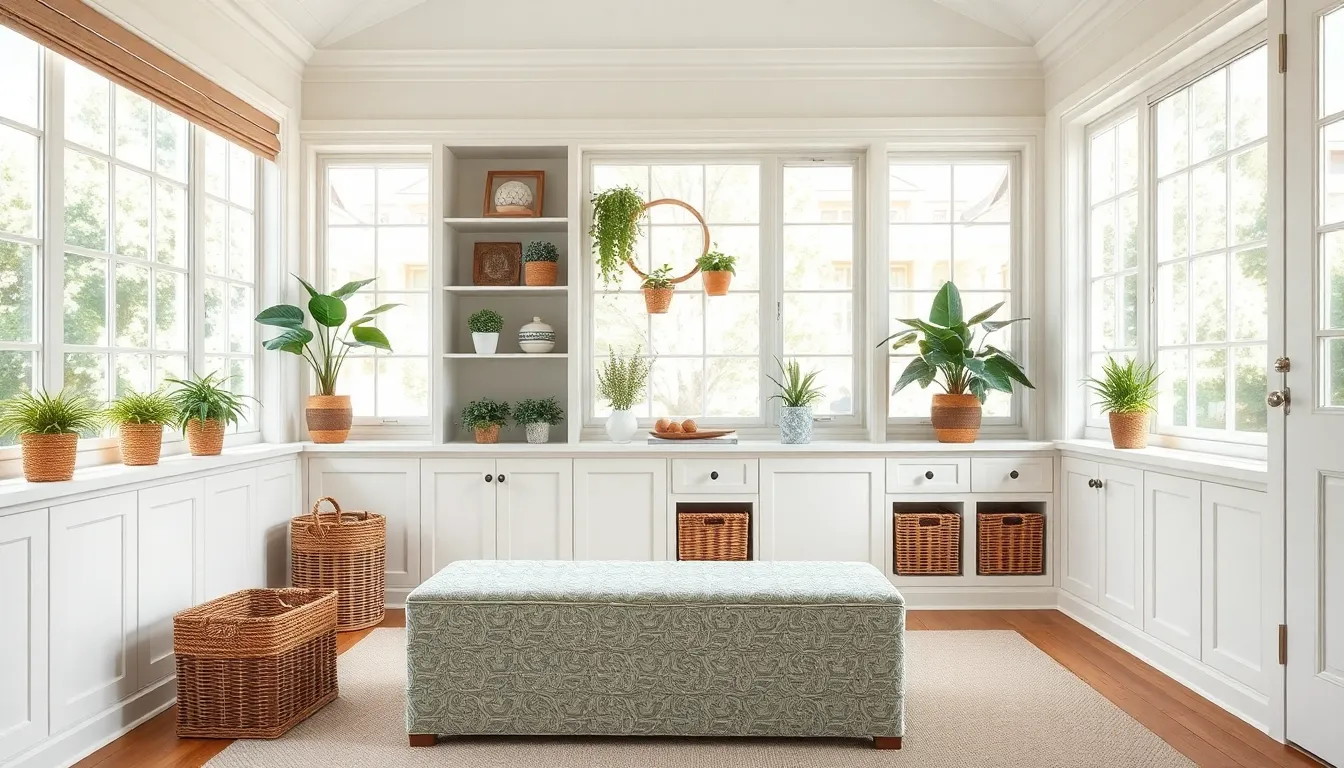
Functional storage transforms our sunroom from a cluttered space into an organized retreat that maintains its bright, airy appeal. We’ll explore creative answers that blend seamlessly with our decor while maximizing every square foot.
Incorporate Built-in Cabinets and Shelving
Built-in cabinets provide seamless storage that becomes part of our sunroom’s architectural design. Custom shelving units can accommodate books, decorative items, and plant collections while maintaining clean sight lines throughout the space. Wall-mounted shelving keeps our floor area completely clear, making the sunroom feel more spacious and easier to maintain during daily cleaning routines.
We recommend installing floating shelves at varying heights to create visual interest while displaying seasonal decor and gardening supplies. Corner cabinets maximize previously unused space and can house everything from outdoor games to extra throw pillows. Built-in options allow us to tailor storage specifically to our sunroom’s unique dimensions and design aesthetic preferences.
Use Decorative Baskets and Ottomans
Decorative baskets serve dual purposes as stylish accents and functional storage answers throughout our sunroom. Storage ottomans offer additional seating capacity while concealing blankets, magazines, or children’s toys behind attractive fabric covers. Wicker baskets complement our sunroom’s natural materials and can be positioned under existing seating or on open shelving units.
We suggest choosing baskets in materials that coordinate with our furniture, such as natural rattan or weather-resistant synthetic weaves. Ottoman storage provides discrete organization for items like gardening tools, create supplies, or seasonal cushions that we need regular access to. Lidded baskets on shelves keep smaller items contained while maintaining our sunroom’s uncluttered appearance.
Create Hidden Storage Under Seating
Window benches with built-in storage compartments add extra seating while keeping essential items accessible yet completely out of sight. Under-seat storage transforms existing furniture into organizational powerhouses without requiring additional floor space or visual bulk. Storage bins placed beneath current seating arrangements can accommodate seasonal recreational gear, extra linens, or outdoor entertaining supplies.
We recommend installing lift-up bench seats along windows to create reading nooks with integrated storage for books and throws. Built-in seating with hidden compartments maintains our sunroom’s streamlined aesthetic while providing practical answers for everyday clutter. Hinged seat cushions on existing furniture can be modified to reveal storage space for items we use regularly but don’t want displayed.
Control Temperature with Ceiling Fans and Ventilation
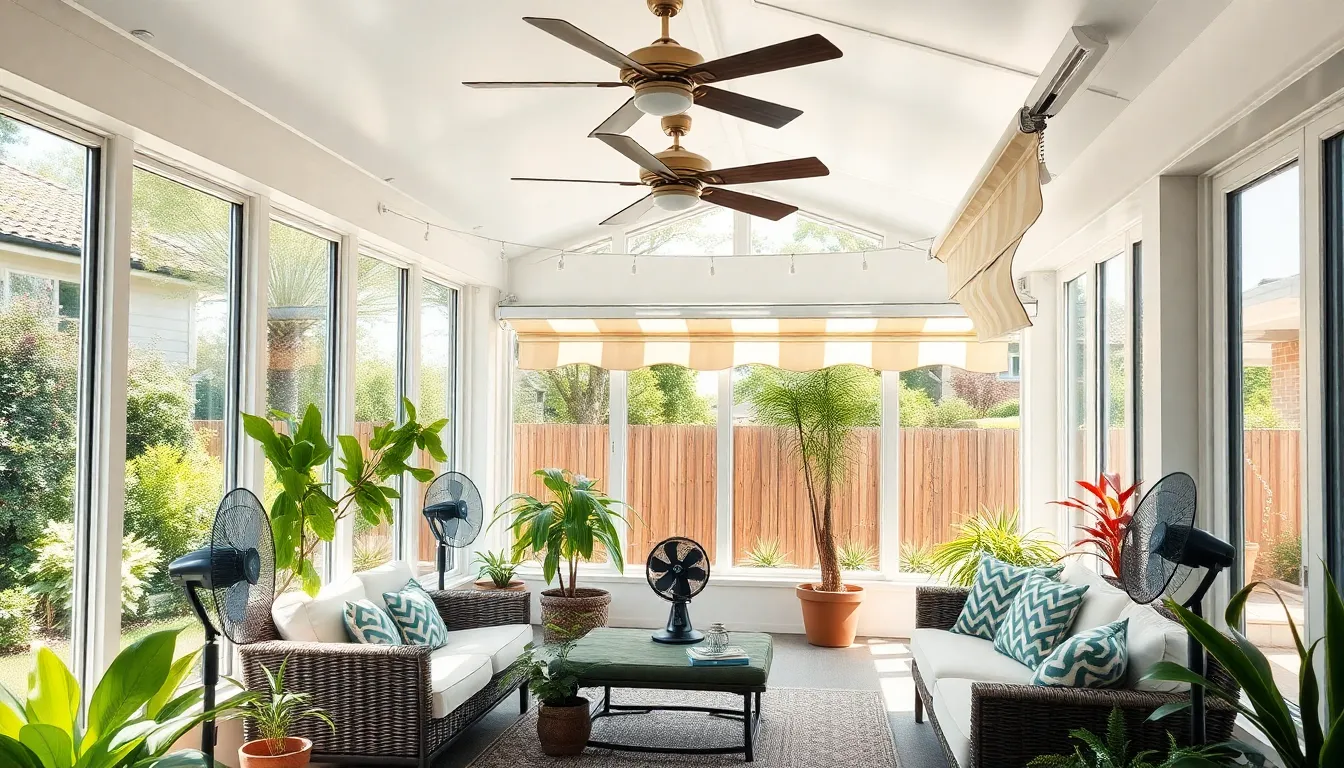
With proper storage answers in place, we can focus on the crucial aspect of temperature control to maintain year-round comfort in our sunroom.
Install Energy-Efficient Ceiling Fans
Energy-efficient ceiling fans serve as the cornerstone of effective sunroom climate control, using less power while maintaining optimal airflow throughout the space. We recommend selecting models with variable speed settings and reversible motor functions, allowing you to create cooling breezes during warm weather and circulate heated air during colder months. Modern energy-efficient fans can reduce electricity consumption by up to 40% compared to traditional models while providing superior air circulation. Position ceiling fans centrally in larger sunrooms or install multiple units in expansive spaces to ensure even temperature distribution across all seating areas.
Add Portable Fans for Extra Circulation
Portable fans offer flexible temperature control answers that complement our ceiling fan installation perfectly. We suggest placing oscillating tower fans near seating areas to create direct cooling effects during hot summer days, while strategically positioning smaller desk fans can target exact zones where family members spend the most time. These portable units work exceptionally well when directed through open windows, drawing in cooler evening air and expelling warm daytime heat. Battery-powered portable fans provide additional versatility for rearranging our sunroom layout without worrying about electrical outlet placement, making them ideal for seasonal furniture adjustments.
Consider Retractable Awnings for Shade
Retractable awnings provide essential shade control that significantly reduces heat gain during the hottest parts of the day while maintaining our sunroom’s bright, airy atmosphere. We can install motorized retractable awnings on the exterior of our sunroom windows to block direct sunlight and reduce glare without permanently altering the space’s natural lighting. These awnings typically reduce interior temperatures by 10-15 degrees during peak sun hours, making our sunroom more comfortable for extended use. Manual retractable options offer cost-effective alternatives, allowing us to adjust shade coverage based on daily weather conditions and seasonal sun angles throughout the year.
Create Ambiance with Layered Lighting
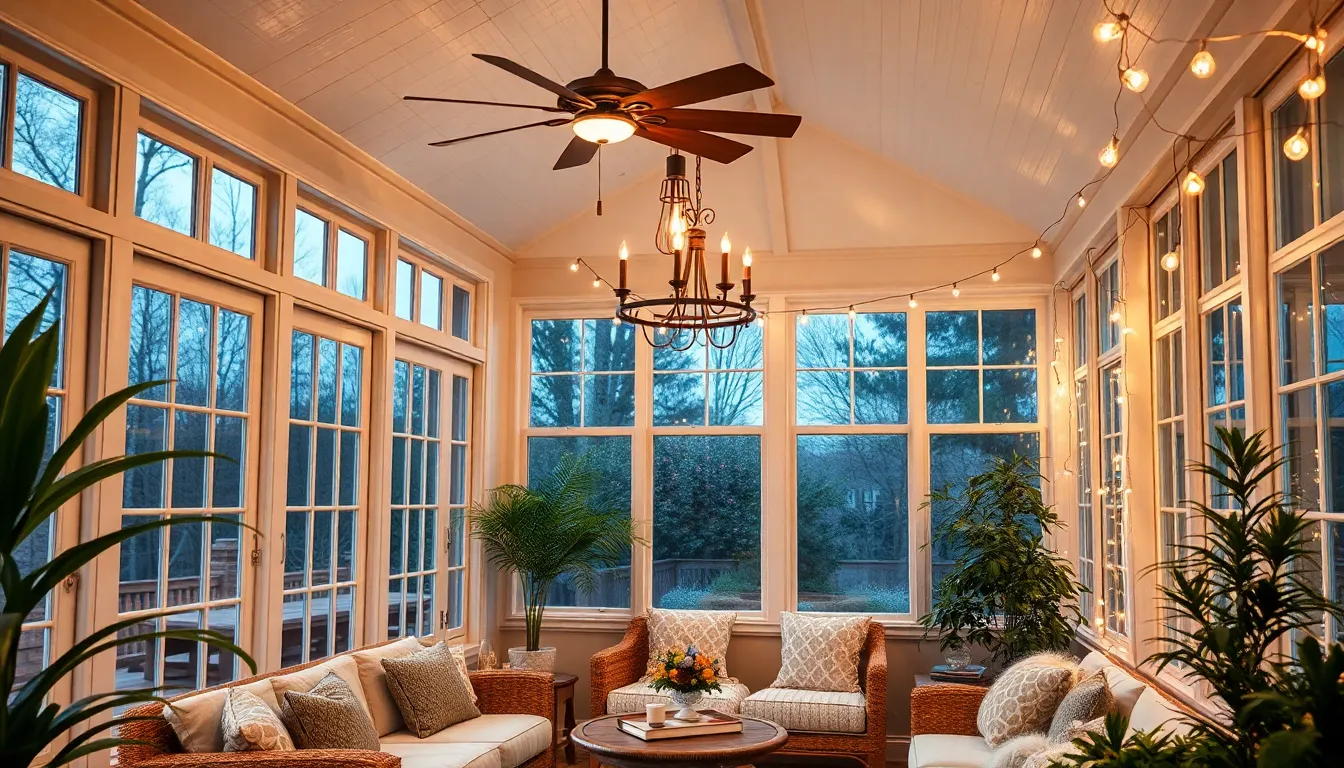
Layered lighting transforms your sunroom into a versatile space that adapts to any time of day or activity. We’ll show you how to blend multiple light sources to create the perfect atmosphere for both daytime enjoyment and evening relaxation.
Combine Natural and Artificial Light Sources
Natural sunlight serves as our primary light source during the day, but we need strategic artificial lighting to maintain functionality after sunset. LED lights on roof panels integrate seamlessly into sunroom designs without requiring an electrician, providing clean overhead illumination that complements the natural light streaming through windows.
Ceiling fans with lights offer dual functionality by circulating air while providing ambient lighting throughout the space. We recommend positioning these fixtures centrally to ensure even light distribution across seating areas and plant displays.
Pendant lights create focal points over dining tables or reading nooks, drawing attention to exact areas while adding visual interest. The Savoy House Ventari Pendant exemplifies modern design that enhances rather than competes with natural lighting.
Wall sconces like the Maxim Revolve Wall Sconce provide task lighting along pathways and beside seating areas, ensuring safe navigation during evening hours. These fixtures work particularly well when positioned to highlight architectural features or artwork.
Install Dimmable LED Fixtures
Dimmable LED fixtures give us complete control over our sunroom’s lighting intensity, allowing us to create different moods throughout the day. These energy efficient options adjust from bright task lighting for reading to soft ambient lighting for evening conversations.
Morning hours benefit from dimmed artificial lights that complement the gentle sunrise filtering through windows. We can gradually increase brightness as natural light peaks during midday, then lower settings again as afternoon shadows lengthen.
Flush mount ceiling lights with dimming capabilities provide general illumination without overwhelming the space’s natural beauty. These fixtures blend into the ceiling design while offering maximum flexibility for various activities.
Smart dimmer switches allow us to preset lighting levels for different times of day, creating automatic transitions that enhance our sunroom experience. We can program these systems to match our daily routines, ensuring optimal lighting without constant manual adjustments.
Add String Lights for Evening Atmosphere
String lights create a magical evening ambiance that transforms our sunroom into an enchanting retreat after dark. These versatile fixtures add warmth and intimacy while providing gentle illumination for nighttime gatherings.
Perimeter placement along the ceiling or around windows creates a soft border of light that defines the space beautifully. We recommend choosing warm white LEDs for a cozy feel that complements both modern and traditional sunroom styles.
Furniture integration allows us to weave string lights around seating areas, creating intimate conversation spaces perfect for evening relaxation. Battery operated options eliminate the need for extension cords while providing placement flexibility.
Seasonal adjustments let us change string light patterns throughout the year, adding festive elements during holidays or creating romantic settings for special occasions. These temporary installations keep our sunroom decor fresh and captivating without permanent modifications.
Personalize with Decorative Accessories
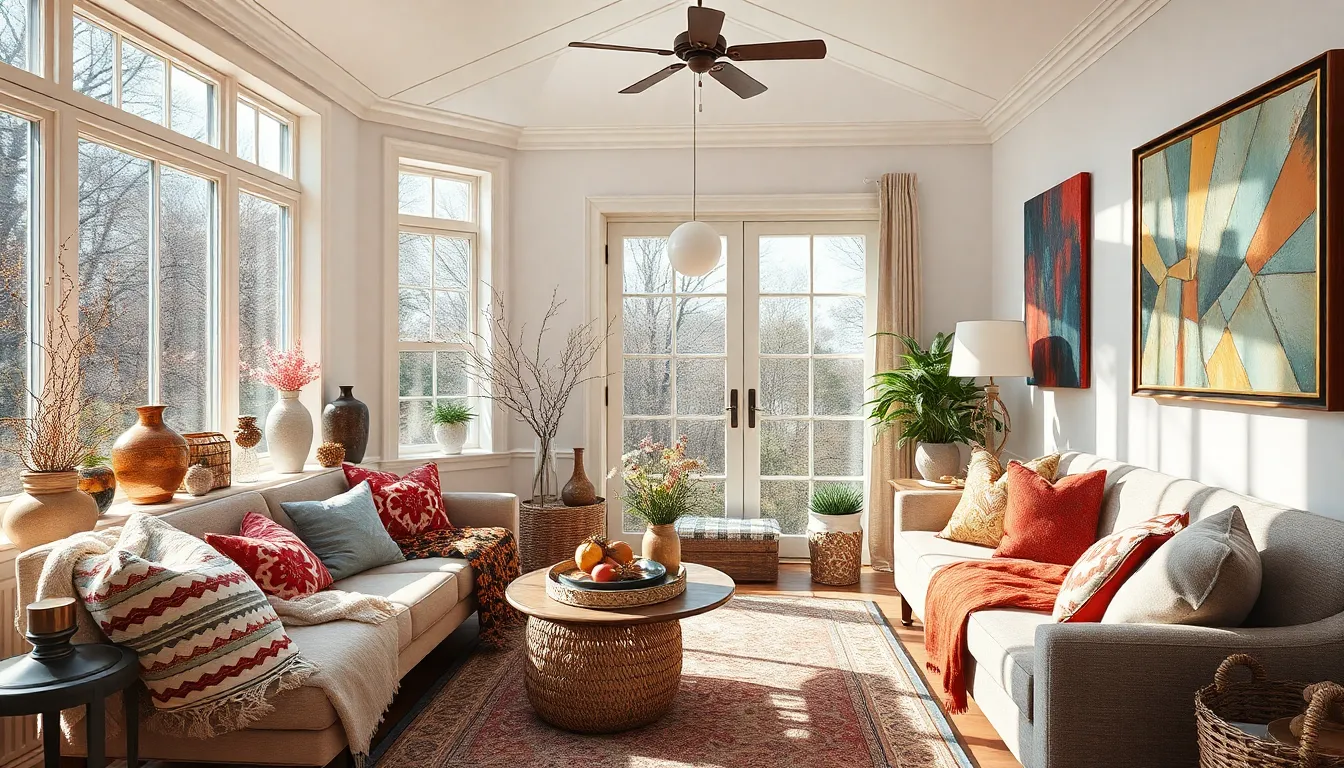
We can transform our sunroom into a unique reflection of our personality through carefully chosen decorative accessories. Small details like vases, candles, and sculptures add charm while making the space feel truly our own.
Display Seasonal Decorations
Rotating seasonal accents keeps our sunroom fresh and connected to the changing environment outside. Beach-themed decor works beautifully during summer months, bringing coastal vibes through seashells, driftwood pieces, and ocean-inspired color palettes. Winter calls for cozy elements like warm blankets, pinecones, and rich textures that create intimate gathering spaces.
Spring decorations celebrate renewal with fresh flower arrangements and pastel accents. We can incorporate Easter-themed displays, bird motifs, and garden-inspired accessories that mirror the awakening industry beyond our windows. Fall brings opportunities for harvest-themed elements like pumpkins, autumn leaves, and warm amber lighting that complements shorter days.
Switching decorative themes quarterly prevents our sunroom from feeling stagnant. Storage answers we’ve already implemented make rotating seasonal items effortless, allowing us to pack away off-season decor while keeping our space organized and purposeful.
Add Artwork and Mirrors
Mirrors strategically placed throughout our sunroom reflect sunlight and visually expand the space. Large mirrors positioned opposite windows double the natural light while creating the illusion of additional square footage. Multiple smaller mirrors arranged in gallery walls add visual interest while maximizing light distribution to dim corners.
Artwork introduces color and character that personalizes our sunroom environment. We can select pieces that complement our existing color scheme while adding pops of personality through paintings, photography, or sculptural elements. Weather-resistant artwork options ensure our chosen pieces withstand temperature fluctuations and humidity changes common in sunrooms.
Combining mirrors with artwork creates ever-changing wall displays that serve multiple purposes. Mixed media arrangements featuring both reflective surfaces and colorful art pieces establish focal points while maintaining the bright, airy atmosphere we’ve cultivated through our color and lighting choices.
Incorporate Textiles and Throws
Textiles create warmth and comfort while adding essential texture to hard surfaces. Area rugs soften tile or wood floors while defining conversation areas we’ve established with our seating arrangements. Throw pillows introduce color patterns and seasonal elements that complement our rotating decorative themes.
Layering soft throws provides comfort during temperature changes throughout the day. We can drape lightweight cotton throws over seating during summer months, then switch to warmer wool or fleece options when cooler weather arrives. These textile layers work alongside our climate control answers to maintain year-round comfort.
Strategic textile placement enhances both visual appeal and functionality. Window treatments we’ve selected can be complemented with coordinating throw pillows and blankets that tie our entire color scheme together. Natural fiber options like jute rugs and linen cushions reinforce the organic connection between our indoor space and outdoor environment.
Conclusion
Creating your perfect sunroom doesn’t have to be overwhelming when you have the right approach. We’ve covered everything from foundational elements like weather-resistant furniture and proper flooring to finishing touches like layered lighting and seasonal accessories.
The key is starting with durable basics and building layers of comfort and style that reflect your personality. Remember that your sunroom should work for you year-round so prioritize functionality alongside beauty.
Whether you’re drawn to lush plant displays or prefer minimalist elegance your sunroom can become the heart of your home. Take these ideas and adapt them to fit your space budget and lifestyle. With thoughtful planning and creative touches you’ll have a stunning retreat that bridges the gap between indoor comfort and outdoor beauty.
Frequently Asked Questions
What color scheme works best for sunroom decorating?
Light and airy color schemes work best for sunrooms to maximize natural brightness. Use neutral tones like soft beiges, gentle taupes, white, and cream as your foundation. These colors reflect sunlight and enhance the spacious feel. Add personality with colorful accessories like vibrant throw pillows and artwork that can be easily changed seasonally.
What type of furniture is best for sunrooms?
Weather-resistant furniture is essential for sunrooms due to unique environmental challenges. Wicker and rattan pieces are ideal for their natural appeal and moisture resistance. Choose all-weather upholstery fabrics like Sunbrella that resist fading and handle temperature fluctuations. Metal furniture and treated wood also maintain their appearance over time.
How can I control light in my sunroom?
Install sheer curtains or light-filtering blinds to transform harsh sunlight into gentle glows while maintaining privacy. Adjustable shutters allow you to control light levels throughout the day. For convenience, consider motorized shades that integrate with home automation systems, enabling instant light adjustments with the push of a button.
What plants work well in sunrooms?
Mix indoor plants like African Violets and Snake Plants with outdoor varieties such as Hibiscus and Orchids for dynamic displays. Create living walls with vertical planters to maximize space. Use hanging baskets and floor planters for vertical interest. The abundant natural light in sunrooms helps most plants thrive beautifully.
What flooring options are suitable for sunrooms?
Durable flooring like tile and stone works best for sunrooms, withstanding moisture, temperature changes, and sunlight exposure. Tile offers water resistance and minimal maintenance, while natural stone provides aesthetic appeal. Luxury Vinyl Plank (LVP) is a cost-effective, moisture-resistant option. Add area rugs to soften surfaces and define spaces.
How can I maintain comfortable temperatures in my sunroom year-round?
Install energy-efficient ceiling fans with variable speeds and reversible motors for optimal airflow. Use portable fans for additional circulation in seating areas. Install retractable awnings for shade control to reduce heat gain during peak sun hours while maintaining natural light. These solutions ensure comfort in all seasons.
What lighting options work best for sunrooms?
Layer natural and artificial lighting for versatility. Use LED lights on roof panels, ceiling fans with lights for dual functionality, and pendant lights as focal points. Install wall sconces for task lighting and dimmable LED fixtures for mood control. String lights create evening ambiance and can be adjusted seasonally.
How can I maximize storage in my sunroom?
Use built-in cabinets and shelving that blend with your decor while maintaining brightness. Decorative baskets and storage ottomans provide dual functionality as stylish accents and practical storage. Create hidden storage under seating like window benches with built-in compartments to keep essentials accessible yet out of sight.

